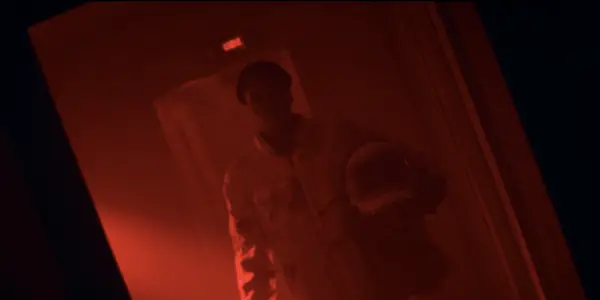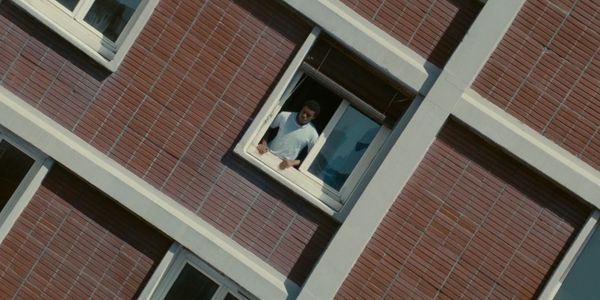GAGARINE: Home is Where The Space Station Is

Soham Gadre is a writer/filmmaker in the Washington D.C. area.…
Gagarine settles on a single metaphor and sticks to it throughout. It traces the communist history and social equity of the Cité Gagarine housing project, named after Soviet astronaut Yuri Gagarin, to its eventual destruction in 21st century France. The film’s central character is also named after Gagarin, though it’s spelled differently – Youri. Gagarine straddles the line between reality and fiction on a singular metaphor throughout its duration. It eventually succumbs to the latter in its final moments, where the tragedy of reality is overcome by the power of the metaphor itself, which ultimately becomes the film’s text.
Shooting for the Stars
Youri (Alséni Bathily) is a passionate fan and student of Yuri Gagarine and the science of space flight. His bedroom has décor of astronauts and he spends time on the rooftop taking care of plants and building space models and suits after growing up and seeing original footage of Gagarin’s reception in Paris of the housing project named after him. The Cité Gagarine housing project in the Parisian suburbs, where Youri grew up, is being torn down now. He of course being the stubborn but brilliantly resourceful youth he is, will not let it happen. With the help of his two friends Diana (Lyna Khoudri) and Houssam (Jamil McCraven), he installs new fluorescent lights in the hallways and tries to renovate as much as possible to pass inspection by the government officials. It’s a tough task and eventually, they fail, but Youri has other plans. He decides to protest the eviction orders he begins to transform his now abandoned apartment building home into the design of a spaceship.

The first shot of Youri in Gagarine is him standing in a doorway, the camera has a red filter and tilts sideways. He is dressed in what looks like a spacesuit. Fanny Liatard and Jérémy Troulih’s direction is in full service of the cosmic motifs that run through the DNA of their movie. The editing and camerawork closely replicate a sense of weightlessness and wonder. The camera tilts, swerves, and orbits around, sometimes pulled by general gravitational shifts in the plane of the movie. They center Youri in the middle of the frame, but he’s always in a passageway or window, traveling from one space or corridor to the next, standing next to a portal or doorway. His motorcycle helmet doubles as an astronaut’s helmet. His red coat doubles for a spacesuit. The building’s latch opening to the terrace makes the same sound that a door in a space shuttle makes.
The StarShip of Communism
There is an inherent irony to the whole thing. Youri’s passion and interest in Gagarin, and in spaceflight, work thematically in competition with his love for his home, on Earth, in Paris, which he doesn’t want to leave. Diana asks him, after mentioning she wants to go to the U.S., “why would you want to be stuck here for the rest of your life?” He doesn’t have an answer really. He figures that if he can’t salvage what he grew up with, he’d rather leave the whole world behind.

He sees developmental shifts in Paris, where French authorities are targeting the homes and livelihoods of lower-income and minority communities. The destruction of Cité Gagarine is symbolic of the historical shifts in French politics – from a housing complex that began as a communist project aimed at equitable living for all, to a Macron-led neoliberal hellscape of financial scams, fractured communities, and isolated poverty.
Conclusion
Gagarine has a lot on its mind but plays it safe and if there’s one flaw to the movie it’s that it is a little too invested in hammering home the central space-travel motif. It comes across as a little shallow in trying to be clever about just one idea for a movie that takes place in a culturally and historically rich complex in Paris. Still, charming and sympathetic portrayals by Alséni Bathily and Lyna Khoudri make Gagarine feel warmly satisfying and make it a passable and peculiar French indie.
Gagarine was in limited release in theaters in the US on April 1st. For more release dates check here.
Have you seen Gagarine? Do you agree? Let us know in the comments below!
Watch Gagarine
Does content like this matter to you?
Become a Member and support film journalism. Unlock access to all of Film Inquiry`s great articles. Join a community of like-minded readers who are passionate about cinema - get access to our private members Network, give back to independent filmmakers, and more.
Soham Gadre is a writer/filmmaker in the Washington D.C. area. He has written for Hyperallergic, MUBI Notebook, Popula, Vague Visages, and Bustle among others. He also works full-time for an environmental non-profit and is a screener for the Environmental Film Festival. Outside of film, he is a Chicago Bulls fan and frequenter of gastropubs.












